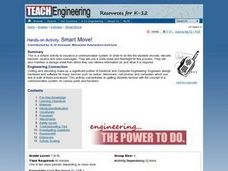Meadows Center for Preventing Educational Risk, University of Texas at Austin
Lesson 9 - Contractions
Is it do'nt or don't? How about doesn't or does'nt? A lesson on contractions helps learners identify, form, and use contractions. Components within the plan include direct instruction on decoding and encoding contractions, as well as...
Florida Center for Reading Research
Word Steps
Blending basic CVC letters to make words is one of the first steps to independent reading. Provided here are several images of stairs and several letters to cut and arrange. The learner rearranges the letters to form CVC patterns, sounds...
Curated OER
Beginning and Ending Sounds - Lesson 1 of 2
Stamp, slap, and clap! Emergent readers demonstrate their awareness of the initial, medial vowel, and final sounds in spoken, short vowel, single-syllable words with a stamp/slap/clap activity. After identifying the letters and sounds of...
Curated OER
Binary and Communication Systems
Students participate in an activity that introduces them to the concept of binary coding as a language. They decode messages using special boards that has its own code for different letters. They create new codes by rearranging wires...
Curated OER
Communications: To the Rescue!
Students role-play as soldiers rescuing lost mountain climbers. Working in teams, they interpret maps to locate the climbers and use flashlights to send and receive coded messages about the rescue. Their goal is to complete the task in...
Curated OER
Smart Move!
Students visualize a communication system. They encode, decode, transmit, receive and store messages. Students use a code sheet and flashlight for this process. They will also maintain a storage sheet from which they can retrieve...
Curated OER
Phonics lesson for "sh"
First graders identify words with the "sh" pattern. They participate in phonemic awareness, decoding, blending, spelling patterns, and dictation exercises. As the assessment portion of the lesson, they may write a story using words...
Curated OER
Clock Arithmetic and Cryptography
Students perform basic operations in modular (clock) arithmetic. Students encode and decode messages using shift and affine ciphers. Students apply their multiplication, division, addition, and subtraction skills.
Curated OER
Cracking the Code
Students explore encoding systems and decoding technology. In this barcoding lesson plan students examine how coding impacts society including distribution, and inventory.
Curated OER
Secret Writing Devices
Elementary and middle schoolers explore the world of secret writing, otherwise known as cryptography. After an interesting introduction to the activity, learners utilize a decoder badge which uses the St. Cyr cipher - which is a cipher...
Curated OER
All Systems Go!
Secret codes are so much fun, and a great way to practice nearly any math skill. Let your class become code breakers as they investigate inverse matrices. They use TI-Nspire technology to solve systems of equations which help them crack...
Institute of Electrical and Electronics Engineers
Cracking the Code
Some interesting reading on the history of barcodes opens this technology lesson plan. Readers find out how engineers contribute, and then they gather into groups to discuss possible improvements to our current UPC barcode system. Know...
EngageNY
Using Matrix Operations for Encryption
Data encryption is an important security measure for sensitive data stored on computers. Pupils learn how to utilize matrices for creating code. They also get a great review of matrix multiplication, inverse matrices, and the identity...
Code.org
Sending Numbers
Binary graphing ... bit by bit. Pairs work together to develop a protocol in order to send the points of a graph. One partner sends the points and the other receives them and tries to recreate the graph. The pupils use the rubric to...
Curated OER
Homophones
Students draw a sketch of each homophone and write sentences with homophones in them. In this homophones lesson plan, students also match homophones in a picture form.
Curated OER
Detective Digis and the Computer Caper
Mathematicians participate in an hands-on activity to investigate the binary number system and write messages in binary code and have classmates decipher the messages. A said video on the topic does not seem to be available, but the...
Curated OER
Matrices: A Secret Weapon
Students perform operations with matrices. In this algebra lesson, students use cryptography and cryptanalysis to solve problems. They add, subtract, and multiply matrices.
Curated OER
Communication
Students practice how to be a good listener. They take a pre-test and then discuss their results. They also practice "I" messages in which they state how someone else's behavior is affecting them.
Curated OER
Cryptography Implementation
Learners explore cryptology. They write a research paper on cryptography. Using linear equations, students invent a code and write a secret message. Learners complete cryptography puzzles.
Curated OER
SHHH It's a Secret
Students rewrite word problems using expressions and equations. In this algebra activity, students use the correct variable to solve and write equations. They use the TI to graph their solution.
Curated OER
Critter? Growth
Students identify and use the elements of the scientific inquiry to solve problems. They explain concepts about the structure and properties of matter. Pupils write an explanation of polymers and how the characteristic of polymers...
Curated OER
Basic Crypto Systems
Students try to solve codes mathematically. The use of a code needs a key. Students try to decipher a code with a mathematical key. This requires focus and higher order thinking skills like analysis.
Florida Center for Reading Research
Florida Center for Reading Research: Encoding and Decoding: Jar Sort
A lesson plan in which young scholars draw letter cards and see how many words they can make from them. Materials are included.
Florida Center for Reading Research
Florida Center for Reading Research: Encoding and Decoding: Vowel Stars
A lesson plan in which students fill in the missing letter with vowels to determine which ones form real words. Materials are included.























